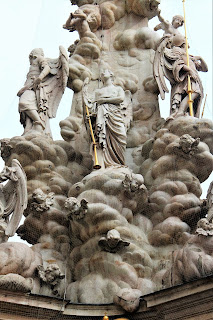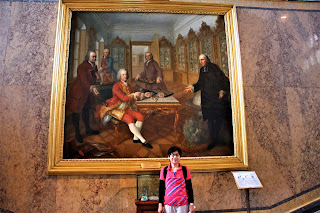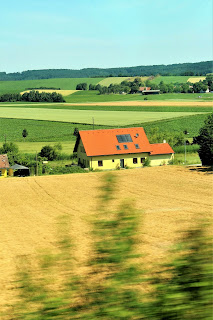Be Casual in Austria in 2015
Part 1
(Travel Story Series @ Hon Too Fang 2021)
Preface
In June 2015 we joined 17 others for a 23-day group tour to Central Europe, setting foot on Austria, Slovakia, Poland and the Czech Republic. This region is now called Central Europe instead of Eastern Europe. This is a "late" travel story. It will be in 4 parts.
Straight forward travel stories. Hope you could take the tour with us. It is free. No hidden cost. No advertisement. This one is be casual, like enjoying the “Sound of Music” in Austria.
Hon
(28-01-2016)
(Note in 2021: for this PDF format, there will be 4 separate stories)
Austria the Country
A landlocked country 84,000 sq km in size (4 times the size of our Perak state) with some 8.6 million people. In ethnicity, 81% Austrians, 3% Germans. The national language is German, not surprisingly, as Austria was part of the greater Germany until WWI. In religion, current estimate says Catholics 62%, Protestants 5% and “no-religion” 20%. Austria is famous in the field of music with many famous composers born or grew up in Austria.
We visited Vienna, Salzburg and Melk.
1 - Vienna
Vienna is the biggest city in Austria and the capital, with a population of 2 million, nearly a quarter of the population of the country. It is famous as a culture center, particularly in the field of music and opera. We were last here 4 years ago while touring Bosnia/Croatia. Now presenting some sights different from those in that story.
Inner City
The famous shopping street in the city center or inner city is Garben which was established during the Roman time. The inner city is a UNESCO World Heritage Site. One landmark building is the Grabenhof dated to 1874 and the famous fountain is the Leopoldsbrunnen dated to the 1640s. The neighbourhood has many buildings decorated in the Art Deco design, 1 shown, as well as one with the more conventional decoration.
The icon on Garben is the elaborately crafted Baroque memorial called the Plague Column or Holy Trinity Column dated to 1694. And more contemporary sculptures near to it.
Also shown are 2 of many wall reliefs found outside a restaurant, and 2 items in a souvenir/craft shop.
Maria Theresa Plaza
This is a big public square between the twin buildings of the Natural History Museum and the Art History Museum. Maria was the daughter of the Holy Roman Emperor and effective ruler of the huge Habsburg Empire from 1740 to 1780. At the centre of the square is the giant Maria Theresa Monument unveiled in 1888 after 13 years of construction. It features Maria sitting at the top with 4 of her generals on horseback, and her advisers directly below her. Shown also a fountain.
(Note in 2021: this Empress Maria was the only female ruler in the 370 years of the Habsburg Dynasty. She worked day and night. During her reign of 40 years her empire fought many wars, negotiated treaties with many warlords in Europe, reformed the government, built many monuments and in between she gave birth to 16 children, with 13 survived through infancy. A remarkable woman.)
Natural History Museum
This is one of the most important nature museums in the World. It was founded by the Crown in 1750 and the present building was completed in 1889. Shown the façade and the interior of the entrance hall, with a statue of Isaac Newton.
The museum keeps over 30 million objects including some 25 million specimens. Really a lot of staff. There is a section on decorative stones with some 500 exhibits. Shown 2 photos of the cut sections of some stones, 2 beautiful shell fossils and 4 from the sea creature section. The long-leg giant Japanese spider crab (last photo) has a span over 2 meters. Yes, 2 meters, giant mah!
Schonbrunn Palace
The No.1 tourist attraction in Vienna is the Schonbrunn Palace, a summer palace of the Habsburg rulers. The palace in its present form was built in the 1740s to the 1750s during the reign of Empress Maria Theresa. It is a UNESCO World Heritage Site.
The land is over 185 hectares in size with a huge French garden. There are 32 status in the garden. The palace has 1,441 rooms. We did tour the interior but no photography is allowed.
At the highest point of the garden is the Gloriette (meaning the elevated structure in a garden) built with recycled material from an old palace. The purpose was to glorify the Habsburg power. The most famous sculpture is the Neptune Fountain constructed in 1780 located below the Gloriette hill. It portrays the sea-god Neptune and his entourage. At the base are 4 tritons who are half-man half-fish. Then the seahorses pulling Neptune’s chariot.
Central Cemetery
The Central Cemetery, established in 1863, is one of the largest cemeteries in the World, around 620 acres with over 330,000 graves. We visited only the Catholic section. The Charles Borromeo Church for funeral service has a beautiful ceiling below the dome and beautiful stained glass decoration.
The cemetery has several single-story buildings to house family tombs of the rich and famous. And also open monumental grave for these individuals.
The cemetery has a special section to honour the famous in the music field, like Beethoven and Johann Strauss I.
Then those for the common people. Shown some unusual graves.
2 - Melk
Melk is a small town about 85 km west of Vienna, with some 5,200 residents. We took the train for a day-visit. Beautiful scenery along the railway track. Delightful street scene in the town. And stunning stained-glass window of the local parish church, Church of the Assumption of Mary.
Melk Abbey
The town is famous for a massive baroque Benedictine monastery named Melk Abbey. The Abbey was founded in 1089. The Benedictines are a monastic order of the Catholic Church established by St Benedict, a 6th century monk from Italy. The existing buildings were built between 1702 and 1736, and extensively restored from 1978 to 1995. The Abbey has managed to escape destruction during the many regional wars since its establishment, partly because of its fame. Very impressive façade indeed. The 1st photo shows the back of the building viewed from the town.
The Abbey Museum has over 10 rooms and is well stocked, mostly religious artefacts. The famous artefact include the 16 wood panels in Room 9 dated to 1502 showcasing Christ from the Passion scene, 2 of the panels shown.
The high point is the Abbey Church, ornately decorated with many statues and frescos. The high altar is dedicated to the martyrdom of the apostles St Peter and St Paul.
The ceiling is decorated with frescos, mostly by J M Rottmayr in the early 1700s, the 2nd photo here depicts St Benedict going to Heaven. The other 2 show wall frescos.
To be Continued…..















































































No comments:
Post a Comment